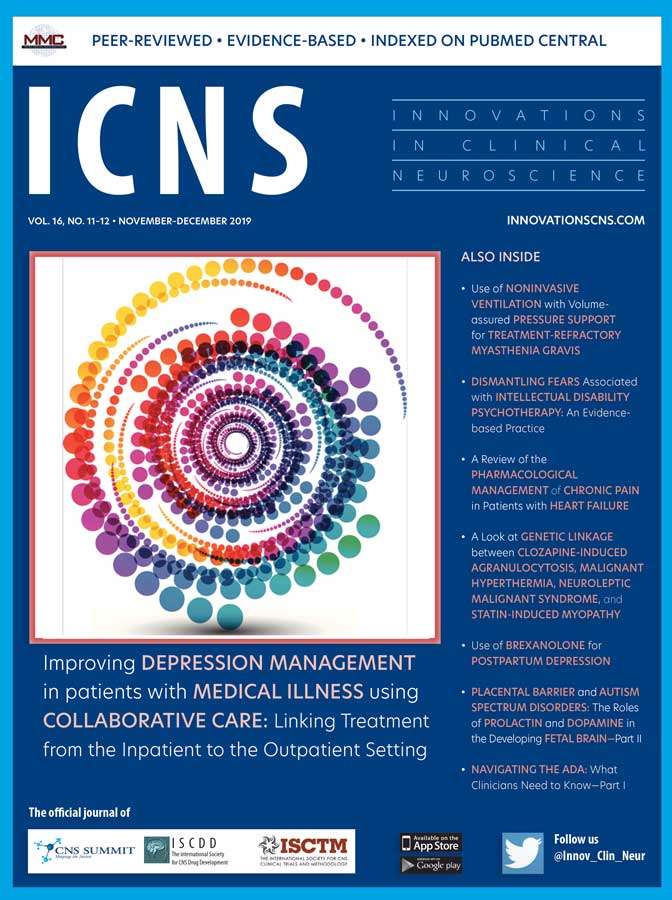 Dear Colleagues:
Dear Colleagues:
Welcome to the November–December 2019 edition of Innovations in Clinical Neuroscience (ICNS). The issue begins with a case report by Diaz et al titled, “Use of Noninvasive Ventilation with Volume-assured Pressure Support for Treatment-refractory Myasthenia Gravis.” The authors share that a stepwise approach to therapy and use of immunosuppressive agents have led to good prognosis and survival rates for those with myasthenia gravis (MD). The authors describe the case of a 54-year-old man with treatment-refractory disease on chronic plasma exchange therapy who responded well to nocturnal noninvasive ventilation with volume-assured pressure mode, which was utilized in his home. He experienced improvements in sleep quality, dyspnea, fatigue, and daytime sleepiness. The authors provide a brief review of MG and highlight the importance of close monitoring and NIV in treatment-refractory cases.
Next, Porcelan et al highlight the higher rate of mental health issues in patients with intellectual disability and traumatic brain injury in this month’s Psychotherapy Rounds article titled, “Dismantling Fears Associated with Intellectual Disability Psychotherapy: An Evidence-based Practice.” The authors emphasize that these patients tend to be more prone to stress, have fewer coping skills, and maintain a smaller system of natural supports. Using illustrative case vignettes, authors review the use of motivational interviewing, cognitive behavioral therapy, and supportive psychotherapy in this special population.
After this, Ishak et al review the impact of depression in patients with comorbid medical problems in their article, “Improving Depression Management in Patients with Medical Illness Using Collaborative Care: Linking Treatment from the Inpatient to the Outpatient Setting.” Ishak et al emphasize the importance of outpatient care for patients with depression and present a plan for the outpatient collaborative care management program that includes new billing mechanisms and costs based on analyzed data from sources such as the Kaiser Family Foundation.
Next, in the article titled “A Review of the Pharmacological Management of Chronic Pain in Patients with Heart Failure,” Majeed et al analyzed reports of heart failure in patients receiving pharmacological treatments for chronic pain. The authors review the risk-benefit ratio and recommend that patient risk profiles should be thoroughly considered before prescribing medication for chronic pain in individuals with heart failure.
In the next article, “A Look at Genetic Linkage between Clozapine-induced Agranulocytosis, Malignant Hyperthermia, Neuroleptic Malignant Syndrome, and Statin-induced Myopathy,” Pothen et al discuss the potential serious reactions associated with Clozapine, including agranulocytosis, malignant hyperthermia (MH), statin-induced myopathy, and neuroleptic malignant syndrome (NMS).
Next, in the article titled, “Use of Brexanolone for Postpartum Depression,” Scarff reviews the newly approved drug brexanolone for the treatment of postpartum depression in women. The author reviews the clinical trial data and discusses the drug’s mechanisms of action, treatment course, and side effects.
Following this, in the article titled, “Placental Barrier and Autism Spectrum Disorders: The Roles of Prolactin and Dopamine in the Developing Fetal Brain—Part II,” Yarlagadda et al propose that elevated dopamine (DA) activity during pregnancy affects neurodevelopment in the fetus and leads to the development of ASD in the child. The authors expand on data from their previously published article that summarized evidence supporting the hypothesis that dysregulated dopamine and prolactin levels are involved in the development of ASDs and in which they proposed a method for assessing whether these dysregulations increase the risk of ASDs. In Part 2, the authors expand on the published data that support this theory and propose a study design to confirm this hypothesis
And finally, we wrap up the issue with our “Risk Management” column. Vanderpool provides information about the legal rights for patients with disabilities in the Q&A article, “Navigating the ADA: What Clinicians Need to Know.”
Sincerely
Amir Kalali, MD
Editor, Innovations in Clinical Neuroscience





